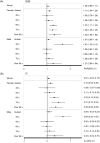Pharmacovigilance study of the association between dipeptidyl peptidase-4 inhibitors and angioedema using the FDA Adverse Event Reporting System (FAERS)
- PMID: 35907939
- PMCID: PMC9338932
- DOI: 10.1038/s41598-022-17366-x
Pharmacovigilance study of the association between dipeptidyl peptidase-4 inhibitors and angioedema using the FDA Adverse Event Reporting System (FAERS)
Abstract
Dipeptidyl peptidase-4 (DPP-4) plays a minor role in degrading vasoactive peptides that cause angioedema when angiotensin-converting enzyme (ACE) is present and fully functional. This study investigated the association between DPP-4 inhibitors (DPP-4Is) and angioedema, including cases where the concomitant use of ACE inhibitors (ACEIs) was absent. We obtained data from the US Food and Drug Administration Adverse Event Reporting System and performed a disproportionality analysis, using the reporting odds ratio (ROR) and information component (IC) for signal detection in patients aged ≥ 40 years, stratified by age group and sex. No signal was detected for DPP-4Is when the entire dataset was analyzed. However, a signal was detected for the entire female subset group, the three stratified female groups aged ≥ 60 years, and males in their 40 s. After excluding the data of concomitant ACEI users, most ROR and IC values were lower and significant only for females in their 60 s and males aged ≥ 80 years. Regarding individual DPP-4Is signals, those detected for saxagliptin and sitagliptin in some age groups disappeared after excluding the data of ACEI users. Notably, linagliptin was the only DPP-4I where signals were detected in most female groups, regardless of age and without concomitant ACEI use. Our findings suggest that some DPP-4Is were associated with a higher reporting of angioedema as per age and sex, even in the absence of concomitant ACEI use.
© 2022. The Author(s).
Conflict of interest statement
The authors declare no competing interests.
Figures


Similar articles
-
Dipeptidyl peptidase-4 inhibitors and heart failure: Analysis of spontaneous reports submitted to the FDA Adverse Event Reporting System.Nutr Metab Cardiovasc Dis. 2016 May;26(5):380-6. doi: 10.1016/j.numecd.2016.02.006. Epub 2016 Feb 19. Nutr Metab Cardiovasc Dis. 2016. PMID: 27067162
-
Cardiovascular safety signals with dipeptidyl peptidase-4 inhibitors: A disproportionality analysis among high-risk patients.Pharmacoepidemiol Drug Saf. 2018 Jun;27(6):660-667. doi: 10.1002/pds.4437. Epub 2018 Apr 14. Pharmacoepidemiol Drug Saf. 2018. PMID: 29655237 Free PMC article.
-
DPP-4 Inhibitors and Increased Reporting Odds of Bullous Pemphigoid: A Pharmacovigilance Study of the FDA Adverse Event Reporting System (FAERS) from 2006 to 2020.Am J Clin Dermatol. 2021 Nov;22(6):891-900. doi: 10.1007/s40257-021-00625-4. Epub 2021 Jul 21. Am J Clin Dermatol. 2021. PMID: 34287770
-
Dipeptidyl Peptidase-4 Inhibitor Induced Angioedema - An Overlooked Adverse Drug Reaction?Curr Diabetes Rev. 2018;14(4):327-333. doi: 10.2174/1573399813666170214113856. Curr Diabetes Rev. 2018. PMID: 28201967 Review.
-
Dipeptidyl peptidase-4 inhibitor treatment and the risk of bullous pemphigoid and skin-related adverse events: A systematic review and meta-analysis of randomized controlled trials.Diabetes Metab Res Rev. 2021 Mar;37(3):e3391. doi: 10.1002/dmrr.3391. Epub 2020 Aug 28. Diabetes Metab Res Rev. 2021. PMID: 32741073
Cited by
-
Interaction between dipeptidyl-peptidase-4 inhibitors and drugs acting on renin angiotensin aldosterone system for the risk of angioedema: a pharmacovigilance assessment using disproportionality and interaction analyses.Diabetol Metab Syndr. 2025 Jan 7;17(1):7. doi: 10.1186/s13098-024-01570-y. Diabetol Metab Syndr. 2025. PMID: 39773243 Free PMC article.
-
Angiotensin-Converting Enzyme Inhibitors and Other Medications Associated With Angioedema.Cureus. 2023 Nov 23;15(11):e49306. doi: 10.7759/cureus.49306. eCollection 2023 Nov. Cureus. 2023. PMID: 38957198 Free PMC article. Review.
-
Adaptation and Linguistic Validation of Angioedema PROMs in Latvian for Assessing Recurrent Angioedema.J Clin Med. 2025 Feb 19;14(4):1375. doi: 10.3390/jcm14041375. J Clin Med. 2025. PMID: 40004905 Free PMC article.
-
Time-to-onset Analysis of Rhabdomyolysis due to Different Proton Pump Inhibitors Using a Pharmacovigilance Database.In Vivo. 2024 May-Jun;38(3):1285-1291. doi: 10.21873/invivo.13567. In Vivo. 2024. PMID: 38688634 Free PMC article.
-
Association of Torsade de Pointes and QT Prolongation With Antifungal Triazoles: Analysis Using a Pharmacovigilance Database.In Vivo. 2023 Nov-Dec;37(6):2719-2725. doi: 10.21873/invivo.13382. In Vivo. 2023. PMID: 37905641 Free PMC article.
References
MeSH terms
Substances
LinkOut - more resources
Full Text Sources
Medical
Miscellaneous

